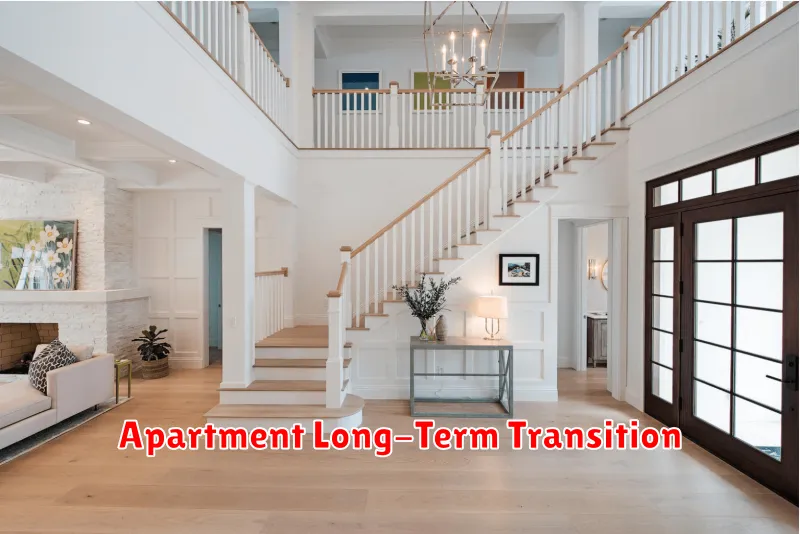Are you tired of the hassle of constantly renewing your short-term apartment rental? Ready for the stability and potential cost savings of a long-term lease? This guide will walk you through a smooth transition, covering everything from finding the perfect long-term apartment to negotiating a favorable lease and understanding the differences between short-term and long-term rental agreements. Learn how to maximize your chances of securing your dream long-term rental and leave behind the stress of temporary housing. Let’s explore the process of upgrading your living situation from short-term to long-term!
Introduction: Making the Shift to Long-Term Renting
Transitioning from short-term to long-term apartment rentals can be a significant change, but it offers substantial benefits. Short-term rentals often come with higher costs per night and less stability. Long-term leases, however, provide predictable monthly payments and greater financial security. This allows for better budgeting and reduces the stress associated with constantly searching for new accommodations.
This shift also offers a sense of stability and belonging. Putting down roots in one place for an extended period allows you to build a stronger connection with your neighborhood and community. You’ll have more time to settle in, personalize your space, and potentially build stronger relationships with your neighbors.
While the initial commitment might seem daunting, the long-term advantages, including cost savings and improved quality of life, make the transition worthwhile. This guide will walk you through the process, addressing key considerations to make your move to long-term renting as smooth as possible.
Step 1: Assess Your Long-Term Housing Needs

Before you even start looking at long-term apartment rentals, take the time to honestly assess your long-term housing needs. This crucial first step will save you time, money, and potential headaches down the road.
Consider these key factors:
- Lifestyle Changes: Are you expecting a family? Will you be working remotely? Do you foresee needing more or less space in the future?
- Budget: Determine a realistic budget that considers not only rent but also utilities, transportation, and potential maintenance costs. Remember that long-term leases often involve higher security deposits.
- Location Preferences: Think about your commute, access to amenities (schools, grocery stores, parks), and overall neighborhood preference. What is important to your long-term quality of life?
- Desired Amenities: Do you need a pet-friendly building? In-unit laundry? Parking? Make a list of your must-haves and nice-to-haves to narrow your search.
- Lease Term Length: While longer leases often offer lower monthly rates, ensure the lease term aligns with your long-term plans.
By thoughtfully considering these aspects, you’ll be better equipped to find a long-term apartment that truly meets your needs and provides a comfortable and stable living environment.
Step 2: Negotiate Extended Lease Terms
Once you’ve decided a long-term lease is right for you, it’s time to negotiate with your landlord. Timing is crucial; initiate the conversation well before your current lease expires (ideally, 60-90 days beforehand).
Begin by expressing your strong interest in extending your lease. Highlight your positive tenancy history – prompt rent payments, responsible upkeep, and respectful behavior. This demonstrates your reliability as a tenant.
Be prepared to discuss lease terms. This includes the length of the new lease (1 year is common, but you can propose other lengths), the rental rate (research comparable units to understand market value), and any desired lease provisions (e.g., pet policies, parking). Be open to compromise, but remember to advocate for your interests.
Consider offering a longer lease term in exchange for a lower monthly rent. This can benefit both you and the landlord, providing them with predictable income and offering you a more affordable price. Alternatively, you might offer to sign a lease renewal with a slight rent increase if the market warrants it.
Document everything in writing. Once you and your landlord agree on terms, ensure the agreement is formalized in a new lease document. Carefully review all clauses before signing.
If negotiations prove unsuccessful, be prepared to explore alternative housing options. Remember that while extending your lease is desirable, it’s not always feasible. Always maintain a professional and respectful demeanor throughout the negotiation process.
Step 3: Check Rental Discounts for Long-Term Commitments
Once you’ve found potential long-term apartments, negotiate! Many landlords offer discounts for signing longer leases. This is a significant advantage of long-term rentals. A longer lease often translates to a lower monthly rent.
Don’t be afraid to ask about potential discounts. Inquire about rent reductions for signing a 12-month or even a 24-month lease. Some landlords might also be willing to negotiate on other terms, such as concessions on security deposits or pet fees.
Research average rental rates in your area for similar apartments. This will help you determine a realistic discount to request. Armed with this information, you can confidently approach landlords and negotiate a deal that works for both of you.
Step 4: Evaluate Moving Costs for Longer Stays
Transitioning from a short-term to a long-term apartment rental often involves a move. This means you need to carefully evaluate the associated costs.
Unlike short-term stays where moving might be less frequent, long-term rentals usually require a more substantial move. Consider the expense of hiring movers, renting a truck, or utilizing moving containers. Factor in potential costs like packing supplies, fuel, and tolls.
Don’t forget potential storage costs if you have belongings you won’t immediately need in your new apartment. Create a detailed budget that includes all these anticipated expenses to ensure a smooth and financially manageable transition. Comparing quotes from different moving services can significantly impact your overall cost.
Time is also a factor. Moving takes time, and if you’re working, you may need to take time off or arrange for help. Consider the opportunity cost of your time when assessing the overall moving expense.
Step 5: Understand Utility and Maintenance Responsibilities
Transitioning from short-term to long-term apartment rentals means understanding your responsibilities regarding utilities and maintenance. Unlike short-term stays where these are often included, long-term leases typically require you to manage them independently.
Utilities like electricity, water, gas, and internet are usually your responsibility. Before signing a lease, clarify which utilities are included and which you’ll need to set up accounts for. Understand the typical costs to budget effectively. Some landlords may offer bundled utility packages, which can simplify things.
Maintenance is another crucial aspect. Familiarize yourself with your lease agreement to understand what repairs are your responsibility versus the landlord’s. Generally, you are responsible for minor repairs (e.g., replacing a lightbulb) while the landlord handles major repairs (e.g., fixing a broken appliance or plumbing issues). Establish clear communication channels with your landlord regarding maintenance requests to avoid disputes and ensure timely repairs.
Documentation is key. Keep records of your utility bills and any maintenance requests, including photos of damages. This will protect you in case of disputes or unexpected expenses. A well-documented history can be invaluable.
By proactively understanding and managing your utility and maintenance responsibilities, you can avoid unexpected costs and ensure a smooth and comfortable long-term rental experience. Clear communication with your landlord is paramount throughout this process.
Step 6: Update Your Lease Agreement for Long-Term
Once you’ve decided to transition from a short-term to a long-term apartment rental, it’s crucial to update your lease agreement. This isn’t simply a matter of extending the current agreement; it often requires a new, comprehensive contract tailored for long-term occupancy.
Key aspects to address in the new lease include the lease term (the length of the rental agreement), rent amount (which may change based on market rates and the lease length), and renewal options. Be sure to clearly define these elements to avoid future misunderstandings.
Review all clauses carefully. Pay close attention to sections covering rent increases, notice periods for termination, maintenance responsibilities, and pet policies (if applicable). Don’t hesitate to negotiate favorable terms, especially if you’ve been a responsible tenant.
It’s highly recommended to have a lawyer review the lease, especially if it’s a complex document or if you’re unsure about any of the clauses. This proactive step can save you potential headaches down the line. A clear and legally sound lease protects both you and your landlord.
Finally, get everything in writing. Ensure both you and your landlord sign and date the updated lease agreement. Keep a copy for your records.
Conclusion: Transitioning Smoothly to Long-Term Rentals
Transitioning from short-term to long-term apartment rentals requires careful planning and execution. By strategically preparing your space, marketing your property effectively, and screening potential tenants thoroughly, you can significantly increase your chances of a smooth and successful transition. Remember to adjust your pricing strategy to reflect the long-term rental market and be prepared for a longer tenant acquisition process than with short-term rentals.
Ultimately, the key to a successful transition lies in understanding the differences between short-term and long-term rental markets. By adapting your approach and managing expectations, you can confidently navigate this shift and enjoy the benefits of a stable, long-term rental income stream. Good communication with prospective tenants is essential to ensure a mutually beneficial agreement.
Remember to consult with legal professionals to ensure compliance with all applicable landlord-tenant laws and regulations in your area. This will help to protect you and your investment, and ensure a smooth transition. Thorough documentation of the lease agreement is also essential to avoid future disputes.

